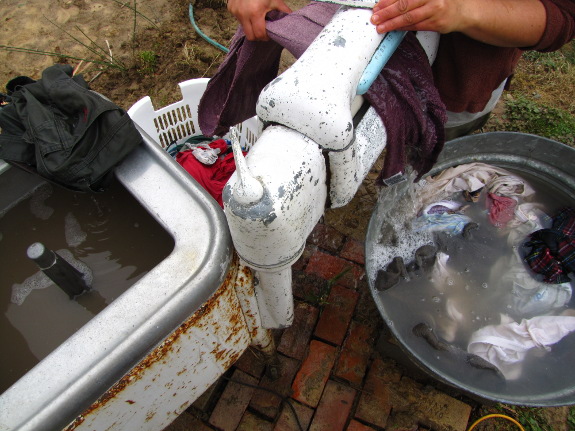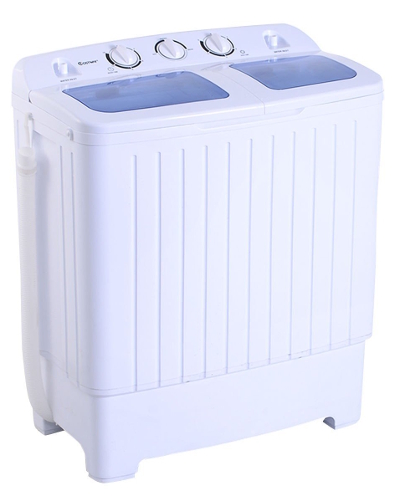
Choosing a washing machine for a tiny home
 When you live in an average
American home, you don't bat an eyelash at filling space with a
conventional washing machine. But in a tiny house, the math is
considerably different. Once you factor in room to open up the door, a
4.2-cubic-foot, front-load washer uses up nearly ten square feet, which
would be almost 2% of the floor space in our small
home!
When you live in an average
American home, you don't bat an eyelash at filling space with a
conventional washing machine. But in a tiny house, the math is
considerably different. Once you factor in room to open up the door, a
4.2-cubic-foot, front-load washer uses up nearly ten square feet, which
would be almost 2% of the floor space in our small
home!
Given that data, you'll
be unsurprised to learn that we've spent the last ten years washing
with alternative devices. My favorite for a long time was the ancient wringer
washer that Mark's grandmother gave us...which has the massive
benefit of being able to live outside. I've really enjoyed open-air
washing, too, but have to admit that since I've been sick, I've wished
certain things around here were a little easier. Specifically, exterior
wringer washers have the disadvantage of freezing your fingers off in the
winter and taking about three times as many active minutes as a
traditional washer.
So why can't you just
put a traditional washing machine outside? We learned the hard way
during our early years on the farm that conventional washing machines
never drain fully. The pump that moves water out of the wash chamber
keeps a bit of liquid in it even after being done, and that leftover
water freezes and busts the surrounding machine in the winter months.
Please don't repeat our mistake --- it's wasteful and it just won't
work.
 Enter a new class of washing
machine that I'd never seen before --- the portable, semi-automatic washer.
These little cuties are meant to be filled and emptied with hoses and
are light enough to easily move outside after use. Best of all, the
model shown here gravity drains, which means it shouldn't have a
freezing issue if we opt to store it on the porch between loads. Even
if you keep the washer inside at all times, it uses a mere quarter of
the floor space of the average front-load washer, so it's a great
choice for apartment dwellers as well.
Enter a new class of washing
machine that I'd never seen before --- the portable, semi-automatic washer.
These little cuties are meant to be filled and emptied with hoses and
are light enough to easily move outside after use. Best of all, the
model shown here gravity drains, which means it shouldn't have a
freezing issue if we opt to store it on the porch between loads. Even
if you keep the washer inside at all times, it uses a mere quarter of
the floor space of the average front-load washer, so it's a great
choice for apartment dwellers as well.
Of course, there are
always downsides. You'll note I called this little device
"semi-automatic" --- that's because you have to manually move your
clothes into a different compartment for the spin cycle and must run
separate wash and rinse cycles. I have a feeling this will be a good
compromise between space constraints and time use and will also suit
our tendency to accumulate dirty clothes slowly, allowing us to run
several small loads per month rather than saving up for one big laundry
day. Stay tuned and I'll report back in once we've given it a spin!
Want more in-depth information? Browse through our books.
Or explore more posts by date or by subject.
About us: Anna Hess and Mark Hamilton spent over a decade living self-sufficiently in the mountains of Virginia before moving north to start over from scratch in the foothills of Ohio. They've experimented with permaculture, no-till gardening, trailersteading, home-based microbusinesses and much more, writing about their adventures in both blogs and books.
Want to be notified when new comments are posted on this page? Click on the RSS button after you add a comment to subscribe to the comment feed, or simply check the box beside "email replies to me" while writing your comment.

10 square feet?
My washing machine has a footprint of 60 cm x 60 cm (let's say 4 square feet) and is 80 cm high (2 ft 7.5 in). As far as I can tell, this is a more or less a standard size for washing machines here in the Netherlands and possibly in Europe. It is meant for maximally 5 kg (say 10 lb) of clothes.
It fits nicely under my kitchen work surface where it lives because my kitchen has a drain connection. (It's uncommon for houses here to have a separate room for laundry. Washing machines here are usually found in the kitchen or bathroom.)
The space for opening the door is not an issue, because it opens in the walking space of the kitchen and I only use it once every week or so.
Thanks to everyone for chiming in with your experiences! Sounds like these little machines are more widespread than I'd thought, and that I should be careful not to overload. (Our wringer washer doesn't remove lint either, so I'm used to that. )
)
And it sounds like similar units might be much more common in Europe. I'm not surprised. I remember when I visited England in 2000, I was surprised to find that families only had what I'd consider a large version of a dorm fridge rather than a normal American fridge. The huge American house market must have similarly selected for oversized washing machines compared to our European counterparts.
My washing machine is a front loader which is more or less standard here. Compared to your small top loader, it has a stainless steel tub and drum, so the mechanics are basically indestructible. It is a 20 years old Zanussi (an Italian brand, don't think you have them in the US?), so it has an electro-mechanical controller instead of a computer. It cost me around $500 back then. New ones are approximately the same price. It uses around 16 gallons for a complete wash cycle which is wash + 2x rinse. New ones use a gallon less.
Using it is a lot less work then a top loader with separate spinner. We used to have one of those when I was a kid. Lots of fun if you like playing with water but otherwise huge, clunky, wet and loud.
You can buy a European style compact washing machine in the USA, but only from the top brands like Miele or Bosch, so they're not cheap. ($1999 for a Miele W3038, $1049 for a Bosch WAP24200UC). Miele and Bosch have always been top brands here. I would expect such a machine to last for at least 20 years.
W.r.t. fridges, the huge two-door style is rare here. Few people here have the space or the need for such a huge thing. For me a two-door fridge would not fit into my kitchen and the supermarket is a three-minute walk. So it's not like I have to store weeks worth of fresh food. People who have vegetable gardens or farm tend to have a separate freezer, though.
People who have vegetable gardens or farm tend to have a separate freezer, though.